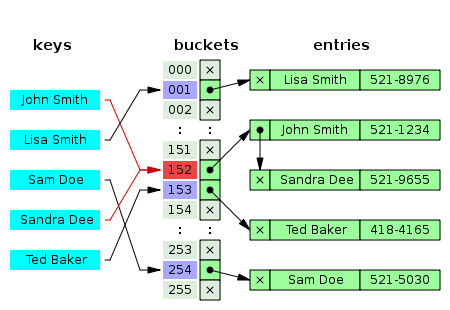HashMap原理及源码解析
2017-12-29 20:27
357 查看
一、what is HashMap( hash table)
In computing, a hash table (hash map) is a data structure which implements an associative array abstract data type, a structure that can map keys to values. A hash table uses a hash function to compute an index into an array of buckets or slots, from which the desired value can be found.
HashMap

二、HashMap工作原理
HashMap的要点:
1、扩展的因子为0.75,初始化长度为16
初始化的时候,Entry的长度为空,第一次put进去的时候,才把Entry数组的长度inflate为初始大小(16)
总的Entry(包括所有桶内的数量)超过临界值,就会resize把桶的数量*2,再重新rehash(重新分配元素)
这一步是为了保证在链表查找的时候,可以保证效率,但是在rehash的时候,会有性能损耗,也因为rehash,让hashMap是非线程安全的。
在java8,会把链表换成了红黑树,让查找和插入的效率都稳定在log(n),当发生碰撞的时候,链表的长度超过8的时候,链表会变成红黑树,以此来提高效率。
hash的值重复,会放进一个链表,找的时候,通过key的equals方法,把相应的值找出来。
put method
inflateTable ,the threshold is the capacity * loadFactor, if gt threshold HashTabl will rehash
here is the resize and transfer code :
when we invoke the get method :
in the JDK8, HashMap use RB-Tree to store the entries
参与资料:
hash table wiki
HashMap 工作原理
HashMap 实现原理
java doc HashMap
In computing, a hash table (hash map) is a data structure which implements an associative array abstract data type, a structure that can map keys to values. A hash table uses a hash function to compute an index into an array of buckets or slots, from which the desired value can be found.
HashMap

二、HashMap工作原理
HashMap的要点:
1、扩展的因子为0.75,初始化长度为16
初始化的时候,Entry的长度为空,第一次put进去的时候,才把Entry数组的长度inflate为初始大小(16)
总的Entry(包括所有桶内的数量)超过临界值,就会resize把桶的数量*2,再重新rehash(重新分配元素)
这一步是为了保证在链表查找的时候,可以保证效率,但是在rehash的时候,会有性能损耗,也因为rehash,让hashMap是非线程安全的。
在java8,会把链表换成了红黑树,让查找和插入的效率都稳定在log(n),当发生碰撞的时候,链表的长度超过8的时候,链表会变成红黑树,以此来提高效率。
hash的值重复,会放进一个链表,找的时候,通过key的equals方法,把相应的值找出来。
put method
/**
* Associates the specified value with the specified key in this map.
* If the map previously contained a mapping for the key, the old
* value is replaced.
*
* @param key key with which the specified value is to be associated
* @param value value to be associated with the specified key
* @return the previous value associated with <tt>key</tt>, or
* <tt>null</tt> if there was no mapping for <tt>key</tt>.
* (A <tt>null</tt> return can also indicate that the map
* previously associated <tt>null</tt> with <tt>key</tt>.)
*/
public V put(K key, V value) {
if (table == EMPTY_TABLE) {
inflateTable(threshold);
}
if (key == null)
return putForNullKey(value);
int hash = hash(key);
int i = indexFor(hash, table.length);
for (Entry<K,V> e = table[i]; e != null; e = e.next) {
Object k;
if (e.hash == hash && ((k = e.key) == key || key.equals(k))) {
V oldValue = e.value;
e.value = value;
e.recordAccess(this);
return oldValue;
}
}
modCount++;
addEntry(hash, key, value, i);
return null;
}inflateTable ,the threshold is the capacity * loadFactor, if gt threshold HashTabl will rehash
/**
* Inflates the table.
*/
private void inflateTable(int toSize) {
// Find a power of 2 >= toSize
int capacity = roundUpToPowerOf2(toSize);
threshold = (int) Math.min(capacity * loadFactor, MAXIMUM_CAPACITY + 1);
table = new Entry[capacity];
initHashSeedAsNeeded(capacity);
}here is the resize and transfer code :
/**
* Rehashes the contents of this map into a new array with a
* larger capacity. This method is called automatically when the
* number of keys in this map reaches its threshold.
*
* If current capacity is MAXIMUM_CAPACITY, this method does not
* resize the map, but sets threshold to Integer.MAX_VALUE.
* This has the effect of preventing future calls.
*
* @param newCapacity the new capacity, MUST be a power of two;
* must be greater than current capacity unless current
* capacity is MAXIMUM_CAPACITY (in which case value
* is irrelevant).
*/
void resize(int newCapacity) {
Entry[] oldTable = table;
int oldCapacity = oldTable.length;
if (oldCapacity == MAXIMUM_CAPACITY) {
threshold = Integer.MAX_VALUE;
return;
}
Entry[] newTable = new Entry[newCapacity];
transfer(newTable, initHashSeedAsNeeded(newCapacity));
table = newTable;
threshold = (int)Math.min(newCapacity * loadFactor, MAXIMUM_CAPACITY + 1);
}
/**
* Transfers all entries from current table to newTable.
*/
void transfer(Entry[] newTable, boolean rehash) {
int newCapacity = newTable.length;
for (Entry<K,V> e : table) {
while(null != e) {
Entry<K,V> next = e.next;
if (rehash) {
e.hash = null == e.key ? 0 : hash(e.key);
}
int i = indexFor(e.hash, newCapacity);
e.next = newTable[i];
newTable[i] = e;
e = next;
}
}
}when we invoke the get method :
/**
* Returns the value to which the specified key is mapped,
* or {@code null} if this map contains no mapping for the key.
*
* <p>More formally, if this map contains a mapping from a key
* {@code k} to a value {@code v} such that {@code (key==null ? k==null :
* key.equals(k))}, then this method returns {@code v}; otherwise
* it returns {@code null}. (There can be at most one such mapping.)
*
* <p>A return value of {@code null} does not <i>necessarily</i>
* indicate that the map contains no mapping for the key; it's also
* possible that the map explicitly maps the key to {@code null}.
* The {@link #containsKey containsKey} operation may be used to
* distinguish these two cases.
*
* @see #put(Object, Object)
*/
public V get(Object key) {
if (key == null)
return getForNullKey();
Entry<K,V> entry = getEntry(key);
return null == entry ? null : entry.getValue();
}
/**
* Returns the entry associated with the specified key in the
* HashMap. Returns null if the HashMap contains no mapping
* for the key.
*/
final Entry<K,V> getEntry(Object key) {
if (size == 0) {
return null;
}
int hash = (key == null) ? 0 : hash(key);
for (Entry<K,V> e = table[indexFor(hash, table.length)];
e != null;
e = e.next) {
Object k;
if (e.hash == hash &&
((k = e.key) == key || (key != null && key.equals(k))))
return e;
}
return null;
}in the JDK8, HashMap use RB-Tree to store the entries
参与资料:
hash table wiki
HashMap 工作原理
HashMap 实现原理
java doc HashMap
相关文章推荐
- JDK 1.7 HashMap原理及源码解析
- HashMap源码及原理解析
- Android 带你从源码的角度解析Scroller的滚动实现原理
- HashMap及HashTable源码解析
- Java线程池架构原理和源码解析(ThreadPoolExecutor)
- HashMap源码解析 给jdk写注释系列之jdk1.6容器(4)
- Andfix热修复框架原理及源码解析-下篇
- LinkedList原理及源码解析
- Java中HashMap底层实现原理(JDK1.8)源码分析
- 第五章 HashMap源码解析
- 【图像特征提取17】ORB原理与源码解析
- HashMap源码解析(基于JDK1.7)
- 深入解析hashcode,hashMap源码
- HashMap原理解析
- java.util.HashMap源码解析
- HashMap实现原理及源码分析
- Spark2.2 Task原理分析及源码解析
- HashMap源码解析二
- Java中HashMap底层实现原理(JDK1.8)源码分析
- 清晰易懂TCP通信原理解析(附demo、简易TCP通信库源码、解决沾包问题等)C#版
